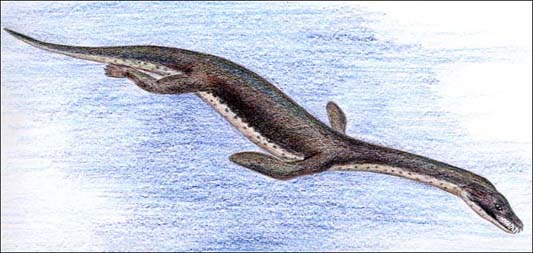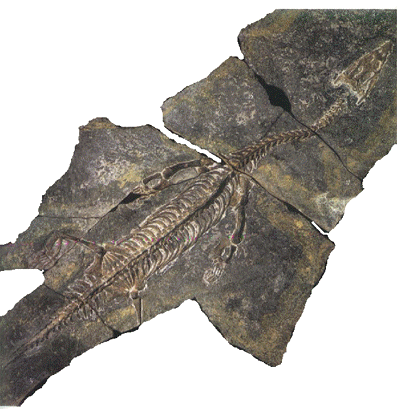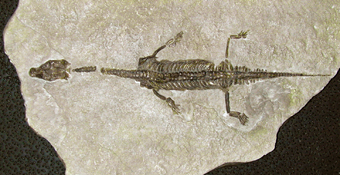
Lariosaurus

Etimology: Reptile from the Lake Lario
Collected Species: Lariosaurus valceresii; Lariosaurus balsami
Systematic Palaeontology: Lepidosauromorpha; Sauropterygia; Nothosauria
Distribution: Kalkschieferzone (upper Ladinian); Calcare di Perledo (upper Ladinian); Grenzbitumenzone (Anisian-Ladinian boundary)
Locality: Ca' del Frate; Perledo; Besano-Monte San Giorgio
Repository: Museo Civico di Scienze Naturali di Induno Olona; Museo Civico di Storia Naturale di Milano; Paläontologisches Institut und Museum Zürich
This is the only reptile so far discovered in the Uppermost Ladinian locality of Ca’ del Frate (Varese, Lombardy) where the Lower part of the Meride Limestone (Kalkschieferzone) crops out. So far, three skeletons have been collected, the holotype (left), which is one meter long a juvenile and a new adult specimen (approx. 80 cm long) currently under preparation.

L. valceresii holotype

The juvenile specimen, about 30cm long.
The skull is typically low and elongated as in other Lariosaurus species, with a very long postorbital region and elongate upper temporal fenestrae, which are larger than the orbits. The rostrum is anteriorly constricted and the anterior teeth are very long and fang-like, procumbent and interlocking each other when the jaws were closed. Parietal and squamosal rise above the occiput to form an occipital crest. In L. valceresii the vertebral column consists of 22 cervical, 20 dorsal, 5 sacral and at least 39 caudal vertebrae. These figures differ from that ones of the best known species L. balsamii from Perledo which has 19 cervical and 22-23 dorsal vertebrae. The cervical ribs show a distinct anterior process and the dorsal ribs are pachyostotic, but the degree of pachyostosis is lower in L. valceresii holotype than in L balsamii.. The caudal ribs decrease rapidly in length and seemingly do not extend beyond the 15-16 caudal vertebra. The pectoral girdle show the typical sauropteygian morphology: it is stout ventrally but low, and the clavicle placed on the anteromedial surface of the dorsal blade of the scapula. The anterior limb is much stouter than the posterior one, as in other Lariosaurus species. Probably the fore-limb played a major role in swimming as suggested for nothosauroids in contrast to pachypleurosauroids. The humerus is stout, but proportionally longer and more slender in L. valceresii holotype than in L. balsami.specimens. The ulna is peculiar in Lariosaurus, it is greatly broadened while the radius is much narrower. Between radius and ulna a wide spatium interosseum is enclosed. There are five or six ossified carpals followed by rod-like metacarpals. Only some phalanges in each digit are preserved thus it is impossible to give a phalangeal formula for the manus in L.valceresiii. The pelvic girdle shows wide pubis and ischium and a tiny ilium with an extremely reduced iliac blade. The femur is slender and approximately of the same length than the humerus in L. valceresii, while it is somewhat longer than the humerus in L. balsami. Tibia and fibula are rod- like enclosing a rather wide spatium interosseum closed distally by a wide astragalus, which is larger than the calcaneum. In the pes, only the first two toes are completely preserved in L. valceresii holotype: the second toe is made by four phalanges, suggesting the presence of a slight hyperphalangy in this species.
The existing differences between L. balsami and L. valceresii render this latter somewhat similar to another sauropterygian, i. e. Ceresiosaurus calcagnii from the Lower Meride Limestone of Switzerland. Ceresiosaurus is much larger than Lariosaurus, it shows hyperphalangy and a humerus which is longer than the femur. However it has been recently considered by Rieppel (1998) not as a distinct genus but as a Lariosaurus species, L. calcagnii.
Click here to see photos of L. valceresii holotype
Click here to see another adult specimen recently found at Ca' del Frate suggest existence of (?sexual) dimorphism in L. valceresii
Click here to see the Lariosaur embryos recently found at Ca' del Frate
Artwork by S. Renesto unless otherwise indicated. Please do not reproduce/repost/republish etc. any text or image without asking permission to the author
Home Research Triassic Reptiles